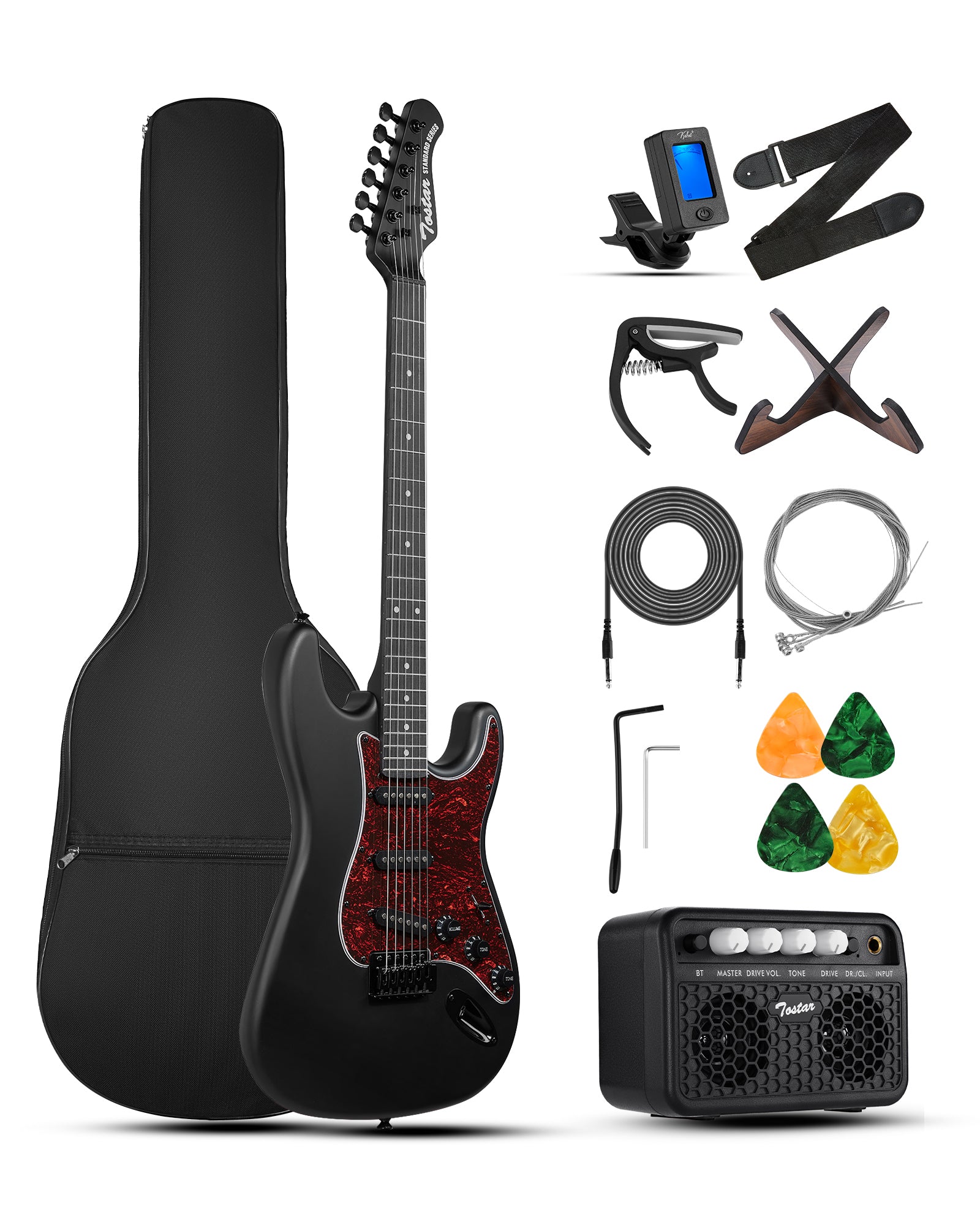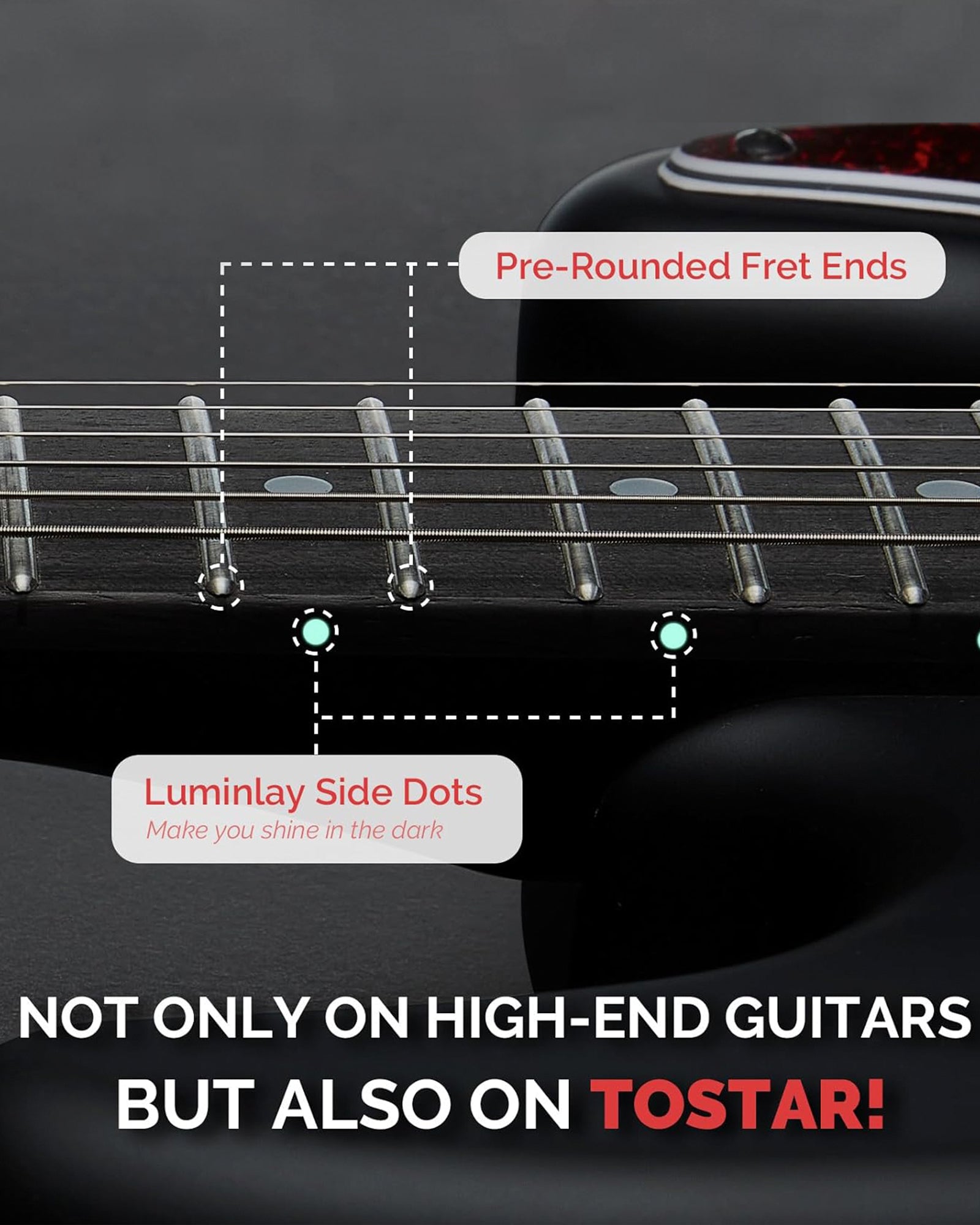 The electric guitar is a gateway to musical expression, powering genres from gritty blues to explosive metal. Its amplified sound, shaped by pickups and effects, offers unmatched versatility for creating everything from soulful melodies to face-melting solos. If you’re new to the instrument, the journey to mastery might seem daunting, but with the right gear and approach, anyone can learn to play. This 1500-word guide focuses on building a strong foundation through practical techniques, effective practice habits, and the right equipment, tailored for absolute beginners. Unlike other guides, we’ll emphasize hands-on exercises, practice routines, and the unique features of the TOSTAR TST-320 to help you progress quickly. Let’s dive in and start your electric guitar adventure!
The electric guitar is a gateway to musical expression, powering genres from gritty blues to explosive metal. Its amplified sound, shaped by pickups and effects, offers unmatched versatility for creating everything from soulful melodies to face-melting solos. If you’re new to the instrument, the journey to mastery might seem daunting, but with the right gear and approach, anyone can learn to play. This 1500-word guide focuses on building a strong foundation through practical techniques, effective practice habits, and the right equipment, tailored for absolute beginners. Unlike other guides, we’ll emphasize hands-on exercises, practice routines, and the unique features of the TOSTAR TST-320 to help you progress quickly. Let’s dive in and start your electric guitar adventure!
Why the TOSTAR TST-320 is Perfect for Beginners
Choosing a beginner-friendly guitar is critical to staying motivated. You need an instrument that’s easy to play, sounds great, and comes with the essentials to get started. The TOSTAR TST-320 Electric Guitar Kit is a standout choice, designed specifically for newcomers with its thoughtful features and all-inclusive accessories.
The TST-320 features a 39-inch poplar wood body, delivering a balanced, resonant tone ideal for rock, jazz, blues, funk, and country. Its roasted Canadian maple neck and laurel wood fretboard offer a smooth, durable playing surface, with the roasting process preventing warping and enhancing durability. The 12-inch radius fingerboard allows low string action, making it easier to fret notes and chords—perfect for beginners. Its H-S-S (humbucker-single-single) pickup configuration, paired with a 5-way switch, provides tonal flexibility, from punchy rock tones to clean, bright notes. The 6-point vintage tremolo bridge enables expressive pitch bends while maintaining tuning stability, thanks to vintage-style tuning machines with split shafts for easy string changes. The ergonomic body design reduces fatigue, and the sky burst metallic finish with black hardware gives it a vibrant, stylish look. The kit includes a 10W Bluetooth-enabled amp, padded gig bag, tuner, four picks, six-string set, bridge wrenches, and a cable—everything you need to start playing without extra costs. Explore the TST-320 here.
Getting to Know Your Guitar
Understanding your guitar’s components sets the stage for effective learning. The TST-320’s poplar body houses H-S-S ceramic pickups, which capture string vibrations and send them to the amp. The roasted maple neck, bolted on for stability, features frets that divide the laurel fretboard into notes. The headstock holds tuning machines, and strings run from the tremolo bridge to these tuners. Volume and tone knobs, plus a 5-way pickup switch, let you shape your sound. The tremolo arm allows pitch manipulation, ideal for dynamic playing. Familiarizing yourself with these parts will make setup and maintenance intuitive.

Step 1: Tuning for Perfect Pitch
Tuning is non-negotiable—every note counts. The TST-320’s standard tuning is E-A-D-G-B-E (low to high). Use the included clip-on tuner: attach it to the headstock, pluck each string, and adjust the tuning pegs until the tuner indicates the correct pitch. Apps like Fender Tune are great backups. The TST-320’s tuning stability, thanks to its high-quality tuners and bridge, minimizes retuning. Practice tuning daily to train your ear. Experiment with drop D tuning (lower the low E to D) later for heavier sounds, but focus on standard tuning first. Tip: Gently stretch new strings to keep them in tune longer.
Step 2: Mastering Posture and Grip
Proper posture prevents discomfort and boosts technique. Adjust the TST-320’s strap so the guitar sits at waist level, whether standing or sitting. For right-handed players, the left hand frets the neck, with the thumb resting lightly behind—think of holding an apple, not a hammer. The right hand picks near the bridge for precision. Hold the included pick firmly between thumb and index finger, angled slightly for clean strums. The TST-320’s C-shaped neck and ergonomic body make long sessions comfortable. Practice strumming open strings to develop a relaxed, natural motion.
Step 3: First Chords for Instant Songs
Chords are your entry to playing songs. Start with two easy open chords: E minor (Em) and A minor (Am). For Em, place your index finger on string 2 (B) at fret 2 and your middle finger on string 3 (G) at fret 2, leaving other strings open. For Am, fret string 2 at fret 1 (index), and strings 3 and 4 at fret 2 (middle and ring fingers). Strum all strings downward, ensuring each note rings clearly. Practice switching between Em and Am, counting “1-2-3-4” per chord to build rhythm. The TST-320’s low string action and smooth fretboard make chord transitions easier. Try “Knockin’ on Heaven’s Door” (G-D-Am) once you’re comfortable—it’s a beginner classic.
Step 4: Strumming and Picking Exercises
Rhythm and precision define great guitarists. Practice a strumming pattern: down-down-up-up-down-up, counting “1-2-3-and-4-and” at 60 BPM (use a metronome app). Keep your wrist loose, letting the pick glide across the strings. For lead playing, try alternate picking on a single string (down-up-down-up), starting with the open low E string, then fretting notes at frets 1, 3, and 5. The TST-320’s H-S-S pickups offer clarity for clean strums and grit for lead lines—use the humbucker for thicker tones. Add dynamics by varying strumming intensity. Aim for 10 minutes daily on these exercises.
Step 5: Scales for Lead Playing
Scales unlock melodies and solos. The A minor pentatonic scale is beginner-friendly: on the low E string, play frets 5 and 8 (index and pinky), then A string frets 5 and 7, D string 5 and 7, G string 5 and 8, B string 5 and 8, and high E string 5 and 8. Practice slowly, ensuring clean notes, then reverse the sequence. Use the TST-320’s tremolo for subtle bends on the high E string at fret 8. Try improvising by mixing these notes over a backing track (search “A minor backing track” on YouTube). The TST-320’s ceramic pickups deliver crisp highs for expressive leads.
Step 6: Building a Practice Routine
Consistency is key. Dedicate 20-30 minutes daily, splitting time across tuning (5 mins), chord practice (10 mins), strumming/picking (10 mins), and scales (5 mins). Use the TST-320’s 10W amp for practice, leveraging its Bluetooth feature to play along with songs or backing tracks. Start with the amp’s clean settings for chords, then switch to the humbucker pickup for scales to add grit. The amp’s headphone jack allows silent practice, ideal for late-night sessions. Track your progress by recording short clips weekly to hear improvements. Vary exercises to stay engaged—alternate between learning a new chord and improvising with scales.
Step 7: Exploring Effects and Sound Shaping
The TST-320’s versatility shines when you experiment with its sound. Use the 5-way pickup switch to explore tones: position 1 (bridge humbucker) for heavy rock, position 4 or 5 (single coils) for clean jazz or blues. Adjust the amp’s tone knob to dial in brightness or warmth. Later, add pedals like distortion for gritty riffs or reverb for atmospheric sounds. The TST-320’s H-S-S setup handles both clean and overdriven tones, making it ideal for discovering your style. Spend 5 minutes per session tweaking settings to understand how they affect your sound.
Step 8: Learning Songs and Building Repertoire
Playing songs keeps practice fun. Start with simple tracks like “Wonderwall” (Em-G-D-Am) or “Sweet Home Alabama” (D-C-G). Use online tabs from sites like Ultimate Guitar, focusing on the TST-320’s clear tone for accurate chord reproduction. Break songs into sections (verse, chorus) and practice each slowly. Aim to learn one song every two weeks, building a repertoire to showcase your skills. The TST-320’s ergonomic design ensures comfort during long practice sessions.
Practice Tips and Resources
Maximize progress with smart habits. Practice in a distraction-free space, using the TST-320’s gig bag for easy storage. Join communities like Reddit’s r/GuitarLessons or watch free YouTube tutorials (e.g., GuitarLessons or Ben Eller). Apps like Yousician offer interactive exercises. Set small goals, like mastering one new chord weekly. If you hit a plateau, revisit basics or try a new song. The TST-320’s stable tuning and smooth fretboard make practice sessions productive.
Conclusion
Learning the electric guitar is about building skills through consistent, focused practice. The TOSTAR TST-320 Electric Guitar Kit, with its versatile H-S-S pickups, ergonomic design, and complete accessory package, is your ideal partner. Its sky burst metallic finish inspires confidence, while its playability accelerates your progress. Pick up your TST-320, tune it up, and start creating music. Your journey to playing like a pro begins now!







How to Play Electric Guitar: A Beginner's Guide
Learn Classic Country Guitar Techniques: Master the Twang and Soul